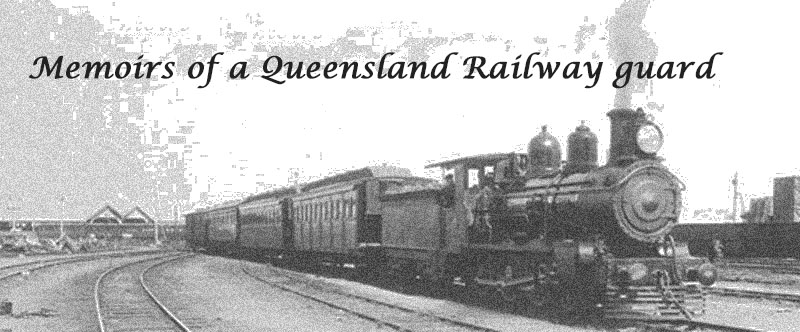|
|
|
|
Introduction PART 1: BYRNES FAMILY ANCESTORS’ CHARTS : (Parents of Peter Byrnes): INDIVIDUAL SUMMARIES
|
The Queensland Times, Friday, Oct 31, 1952: Railway Service A Guard’s Experiences – 5 (by T.A. Byrnes) In my previous article I drew attention to the various classes of trains. I have worked numerous livestock trains during my career as a guard. The Brisbane Valley line, principally Benarkin, Linville, Toogoolawah and Esk, have sent many thousands of cattle to the meatworks sidings. Cattle loaded at Dugandan, on the Fassifern branch from Coochin Estate, were prime beef, and could always be recognised by their white faces. I recall working livestock trains from the Ipswich district many years ago, to Messrs Baynes Bros.’ siding at Belmont. This line, a private one, branched off the Cleveland line at a point near Morningside station. The rails have long since been pulled up. The late driver George Moore and myself were the crew on many trains from Ipswich to this branch. The Redbank Meatworks siding took delivery of a large number of cattle. These works are now converted into the Redbank woollen mills. I also remember working long livestock trains to the QME on the Pinkenba line. I worked many trains on this branch with the late drive Tom Toon. The QME siding is now converted into a plywood siding. The livestock today is now treated at the abattoirs at Cannon Hill. DROVER’S BATTERY During my latter years on the livestock trains, the drover’s compartment in the KB vans was situated on the opposite end of the guard’s compartment. He does not travel with the guard as in earlier years. A goodly number of drovers in charge of cattle carried a “battery” in a small case, with a long cord attached to a pole. When a bullock is down in the wagon, the method of the drovers is to apply the battery to the animal to try to get him on his feet again. There is no regulation to prevent the drovers using the instrument, and I think a by-law should be brought in to abolish it. If a jockey uses a battery he is sent out for life. A method I have used myself is the simple one of getting a bucket of cold water and pouring it into the bullock’s ear. If he is not badly hurt, he will then rise on his feet. TRAIN ACCIDENTS There have been three cattle train accidents on the Brisbane Valley branch. Nearly half a century ago, a serious smash occurred coming down Mount Hallon, from Esk, when a number of livestock were killed. About 40 years ago, a Brisbane train crew met with disaster coming down Pine Mountain bank and many cattle were either killed or maimed. The guard was M. Beck. I recall this disaster as I was returning from Esk on a goods train and following this train down. When we arrived at Fernvale, I was advised of the accident, and was delayed several hours there. I remember the local hotelkeeper (Mr P Kennedy) providing our train crew with a hot breakfast. The third accident happened about 25 years ago at the foot of the Benarkin Range, near Linville. A cattle train, with guard James Holbeck in charge and drive Don Jeffrey, comprised eight K wagons and one KB van of 160 head of cattle. There was also a water wagon next to the engine. This completed the whole train. Near the foot of the range, the water wagon left the line and all the K wagons, with the exception of the KB van and engine, were also derailed. The train crew escaped injury. MURPHY’S CREEK This disaster was one of the major railway accidents in Queensland. It happed on January 28, 1913. A livestock train departed from Toowoomba on the morning of January 28, 1913, with guard J Scanlan and driver Tom Doyle, of the Ipswich staff. When near the 84-mile peg, on the Toowoomba side of Murphy’s Creek station, a number of K wagons, loaded with livestock, left the line and toppled over into the creek below. Many hundreds of cattle were killed. A breakdown train was sent to the scene of the disaster to clear the line for traffic, and next day a relief train from Toowoomba ran into the men working on the breakdown, with the result that six men were killed and several were seriously injured. Mr A P Lloyd was the General Manager, and Mr M. Carmody was the district Manager investigating.
|
